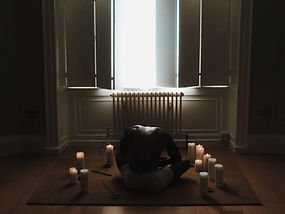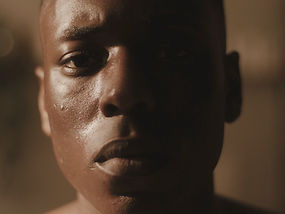Artworks
Vertigo
The project "Vertigo" was conceptualized with the aim of comprehending the intrinsic state of human beings, namely "anxiety," within an existential framework. Its overarching objective was to reassess the ontological yearning for falling that arises from such anxiety, thereby offering solace to individuals grappling with existential despair.
"Vertigo" represents an endeavour to explore the manner in which individuals, thrust into the world and confronted with existence, should confront the pervasive feelings of "anxiety" elucidated in Sartre's seminal work, "Being and Nothingness," as well as the ontological context expounded in Heidegger's magnum opus, "Being and Time." Concurrently, it strives to accentuate these themes through the adaptation of a specific segment from Milan Kundera's novel, "The Unbearable Lightness of Being," by means of two distinct artistic outputs: a video-based installation and a film.
This artistic endeavour places significant emotional emphasis on the dream sequences involving the main character, Tereza, in Milan Kundera's literary masterpiece, "The Unbearable Lightness of Being," thereby bringing to the forefront the existential "anxiety" that permeates the narrative. The presentation unfolds through the projection of two videos, strategically displayed on both the walls and ceilings. The audience experiences the work through the process of following the flow of Teresa's emotions in the cited part of the novel. The initial video projected on the wall serves to evoke introspection and prompts existential inquiries regarding its own existence. It portrays Tereza, who tries to preserve his own existence amidst the looming threat of its erosion. The character of Tereza becomes consumed by anxiety as he confronts the potential loss of the very foundations of his being. Once the video projected on the wall concludes, attention shifts to the ceiling, where a subsequent video begins its projection. To observe the image displayed on the ceiling, the audience gazes into a mirror positioned beneath their feet. In this configuration, Tereza, who finds solace and stability within an environment that emphasizes physical group identity, is revealed through the Tableau vivant technique. The act of viewing the video through the mirror induces a sense of vertigo within the audience, simultaneously serving as a poignant reminder that "vertigo" represents a profound yearning for an ontological falling into the state of “being-in-itself." In other words, audiences who experience observing Thereza's most stable emotions are at the same time in a state of vertigo.
Furthermore, it is imperative to underscore that the original portrayal of Tereza's gender was altered to male, in order to mitigate potential misinterpretations stemming from the inherent complexities of existentialist narratives, which are occasionally misconstrued as feminist narratives. Simultaneously, this modification was motivated by a sense of obligation to alleviate the tendency for a male artist to accentuate the female body.
There are two versions of this work, the installation version of vertigo and the movie version of Tereza's dream was nothing but her vertigo.
The installation is designed to allow the viewer to see Tereza's dream in the material world and feel vertigo at the same time, while the film is designed to tell the narrative of vertigo through the conflict created by the components of the three scenes.






Inspiration
[1]Anxiety
“I'm scared. I feel a little crazy. I'm not lucid. The assumptions are right. I can feel my fear growing. Now is the time for the answer. Just one question. One question to answer”
->Charlie Kaufman <I’m thinking of ending things>
“I have had to experience so much stupidity, so many vices, so much error, so much nausea, disillusionment, and sorrow, just in order to become a child again and begin anew. I had to experience despair, I had to sink to the greatest mental depths, to thoughts of suicide, in order to experience grace.”
->Hermann Hesse <Siddhartha>
[2] Vertigo
"Anyone whose goal is 'something higher' must expect someday to suffer vertigo. What is vertigo? Fear of falling? No, Vertigo is something other than fear of falling. It is the voice of the emptiness below us which tempts and lures us, it is the desire to fall, against which, terrified, we defend ourselves.”
->Milan Kundera <The unbearable lightness of being>
“Vertigo is anguish to the extent that I am afraid not of falling over the precipice, but of throwing myself over”
-> Jean-Paul Sartre <Being and Nothingness>
[3]Tableau vivant
Lars von Trier<Melancholia>
Werner Fassbinder <Katzelmacher>
Secondary Research


[1]Anxiety
[2]Falling
(Dinishak. 2012)
[3]Adaptation
“In a situation where the unique conventions of various mediums are disappearing, it is essential to contemplate strategies for adapting various media into film. The problem of effectively implementing the vast realm of imagination inherent in theater, such as plays and particularly dramas, into the realm of film has been a challenge for directors of this era as well as for the classical filmmakers.”
The comparative analysis between 'Macbeth' and 'Othello' of Orson Welles
(Chough Song Duk, 2013)
[4]Tableau Vivant
“Here, tableau can be understood as a physical movement and introspective attitude that transcends the plot, thus gaining an advantage in the analysis of the relative arrangement of visual images. This particularly allows the audience to transcend the continuity of events and turn it into a wondrous sensation, maximizing the emotional impact of the play by appealing directly to the heart. It serves as a reminder of the essential nature of theatrical tableau.”
The film-aesthetic of Tableau -R.W. Fassbinder and A. Kaurismaki-
(Bae Sang-Joon, 2013)
Selected Context
People may think I'm possessive. No, I just can't stand my body being treated the same as others. It is suffering. At the same time, being special is painful.
My mother always said that all bodies have the same value. She had radically broken with the modesty ceremoniously using her new immodesty to draw a dividing line through her life and proclaim that youth and beauty were overrated and worthless. “Tereza can’t reconcile herself to the idea that the human body pisses and farts. What’s so terrible about that?” She demanded justice. That is why she insisted I remain with her in the world of immodesty, where the world is nothing but a vast concentration camp of bodies, one like the next, with souls invisible. Is that why I can not be loved?
I want you to be old. I want you to be weak. As weak as I am. I’m thinking of vertigo.
I have come to him to escape my mother’s world, a world where all bodies were equal. I have come to him to make my body unique, irreplaceable. But he, too, had drawn an equal sign between me and the rest of them: he kissed them all alike, stroked them alike, made no, absolutely no distinction between my body and the other bodies.
I suddenly felt a desire to move together and end my life together, surrounded by all the bodies. A body that lost the biggest battle of my life. Just go off on your own!
My Mom always said. Who do you think you are, anyway? That is quite a relief. I’m thinking of vertigo. I’m eager to fall.





Installation Plan / Images











Exhibition
Photography of Vertigo was showcased in the exhibition <You are innocent in your Dream>, organised by Zero Feed Back Tokyo and held at Zero space Tokyo
14th Sep - 29th Sep 2024.







